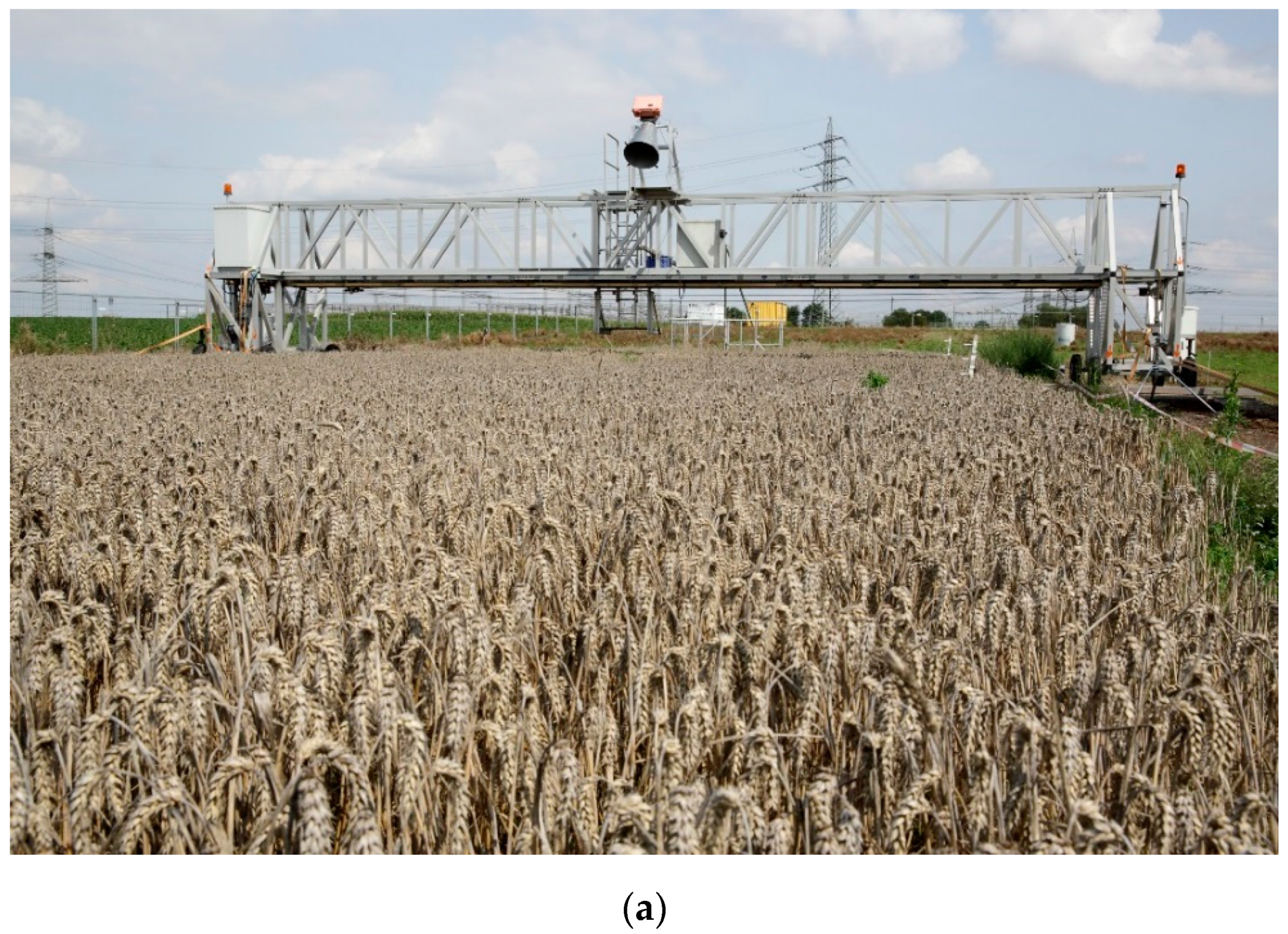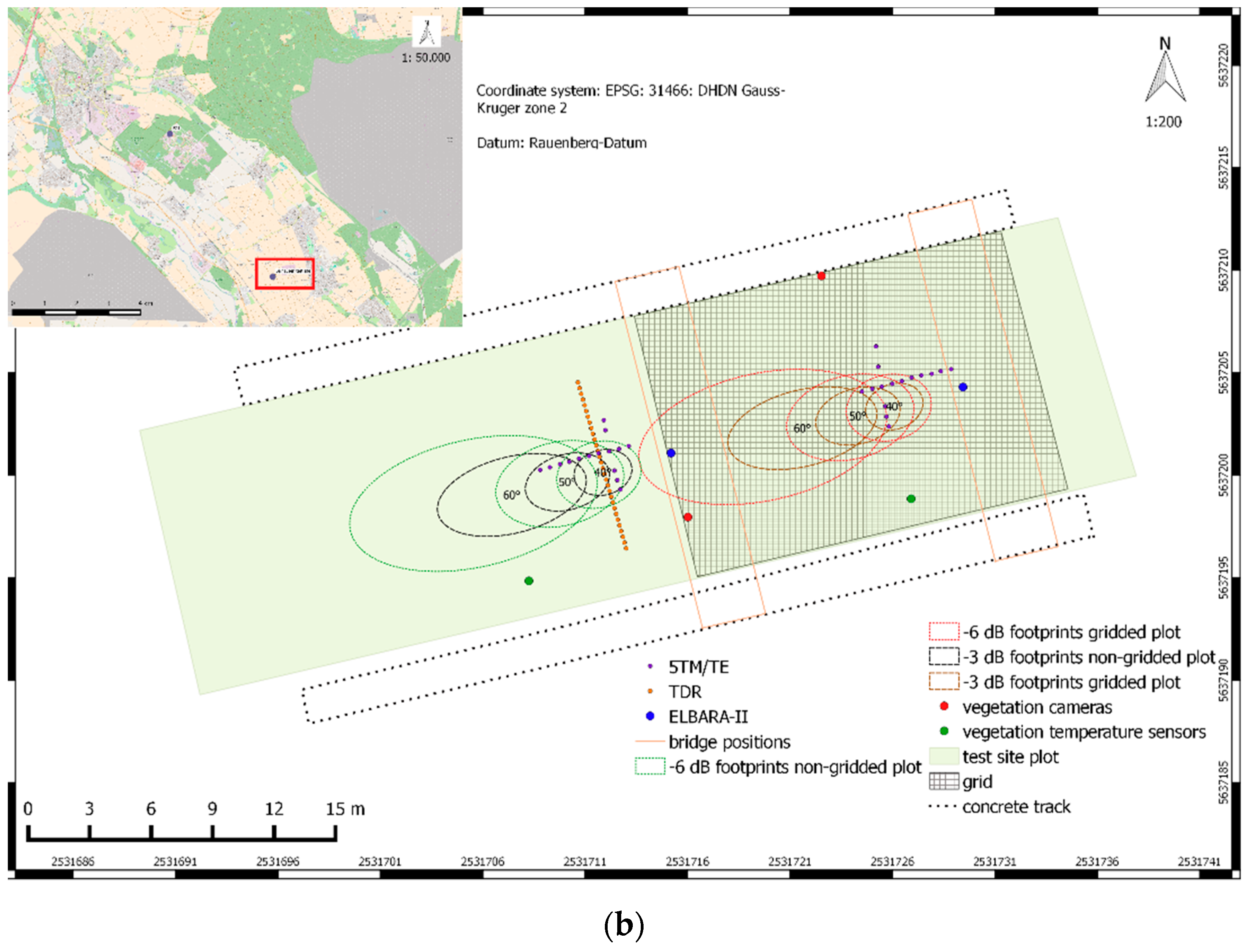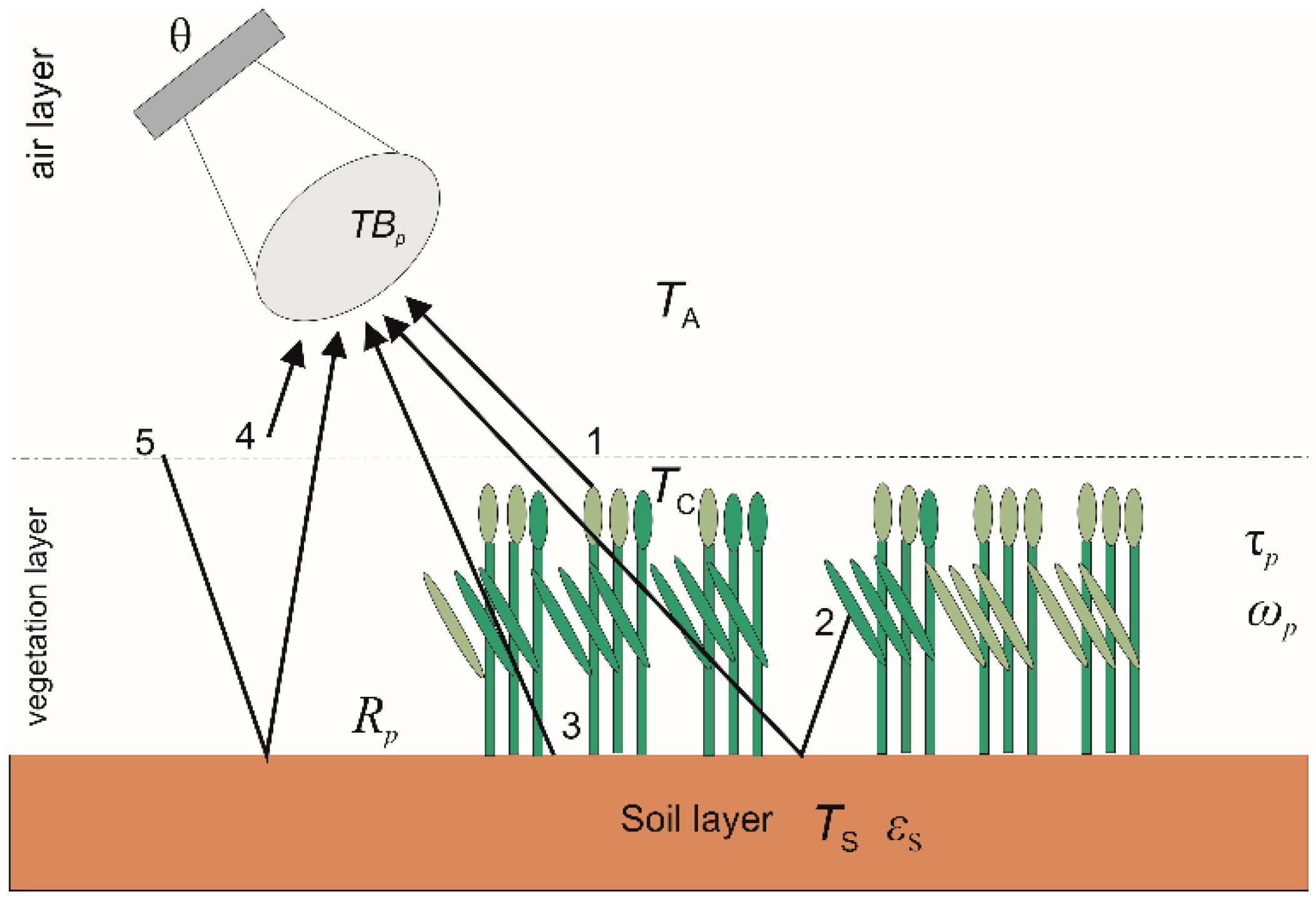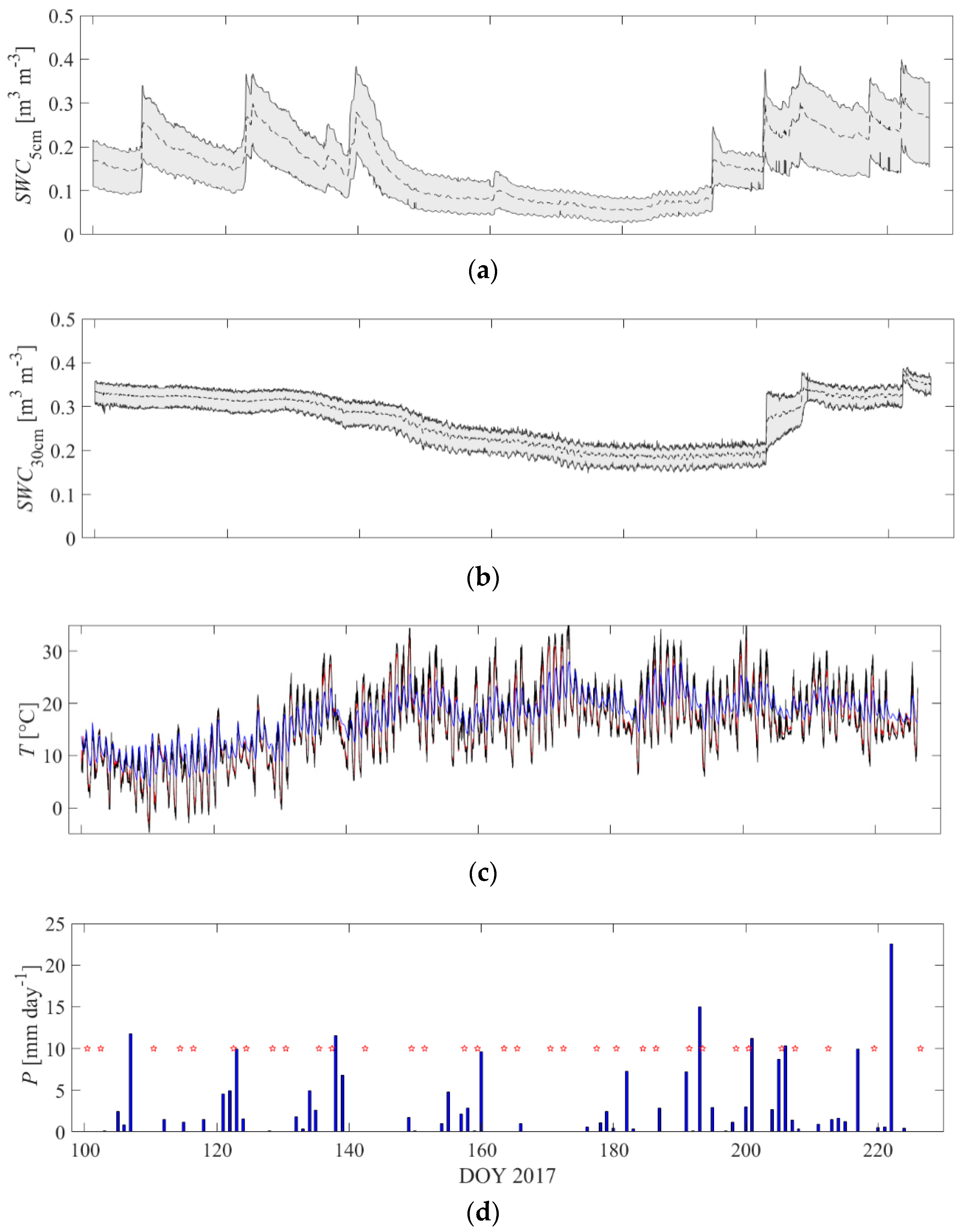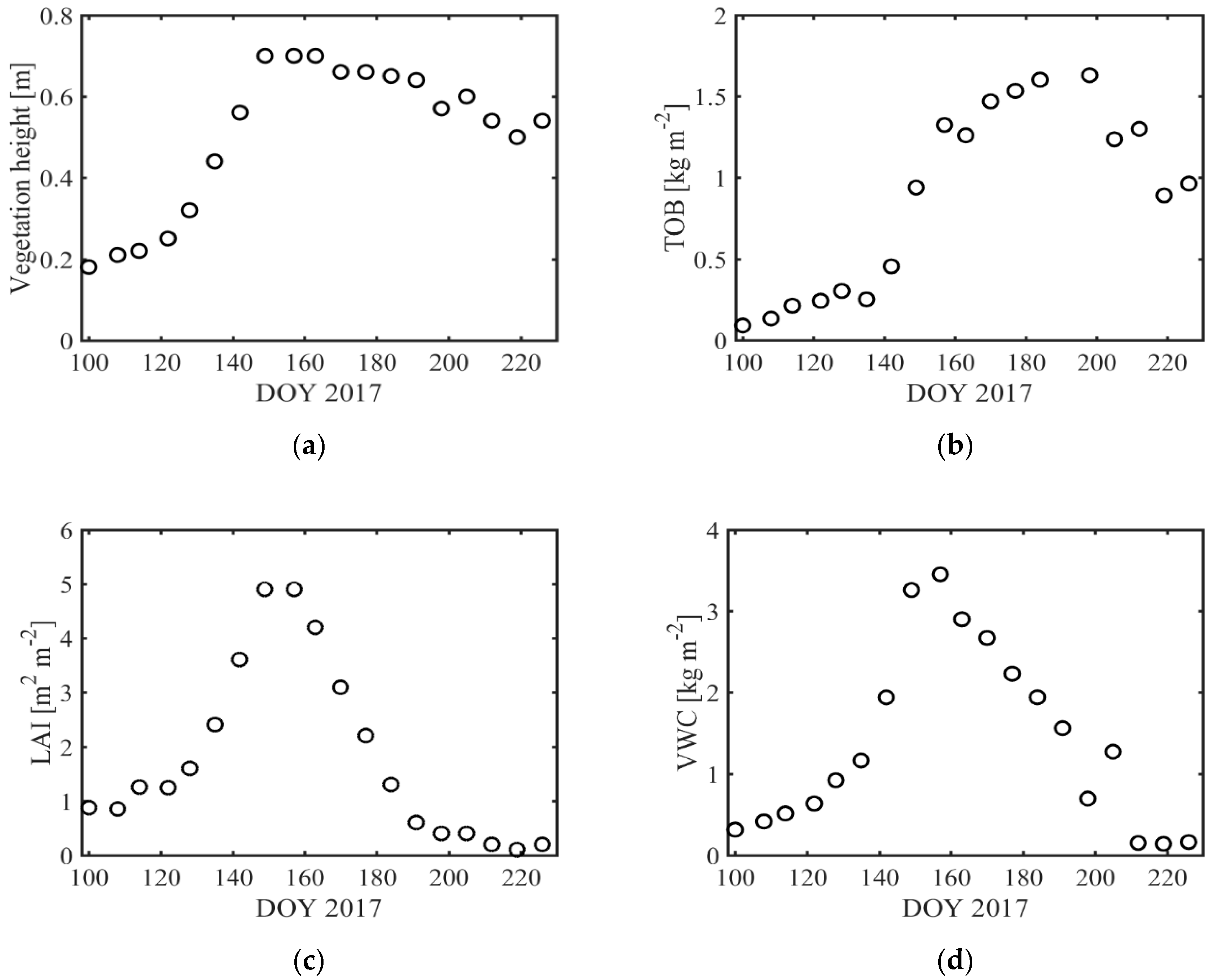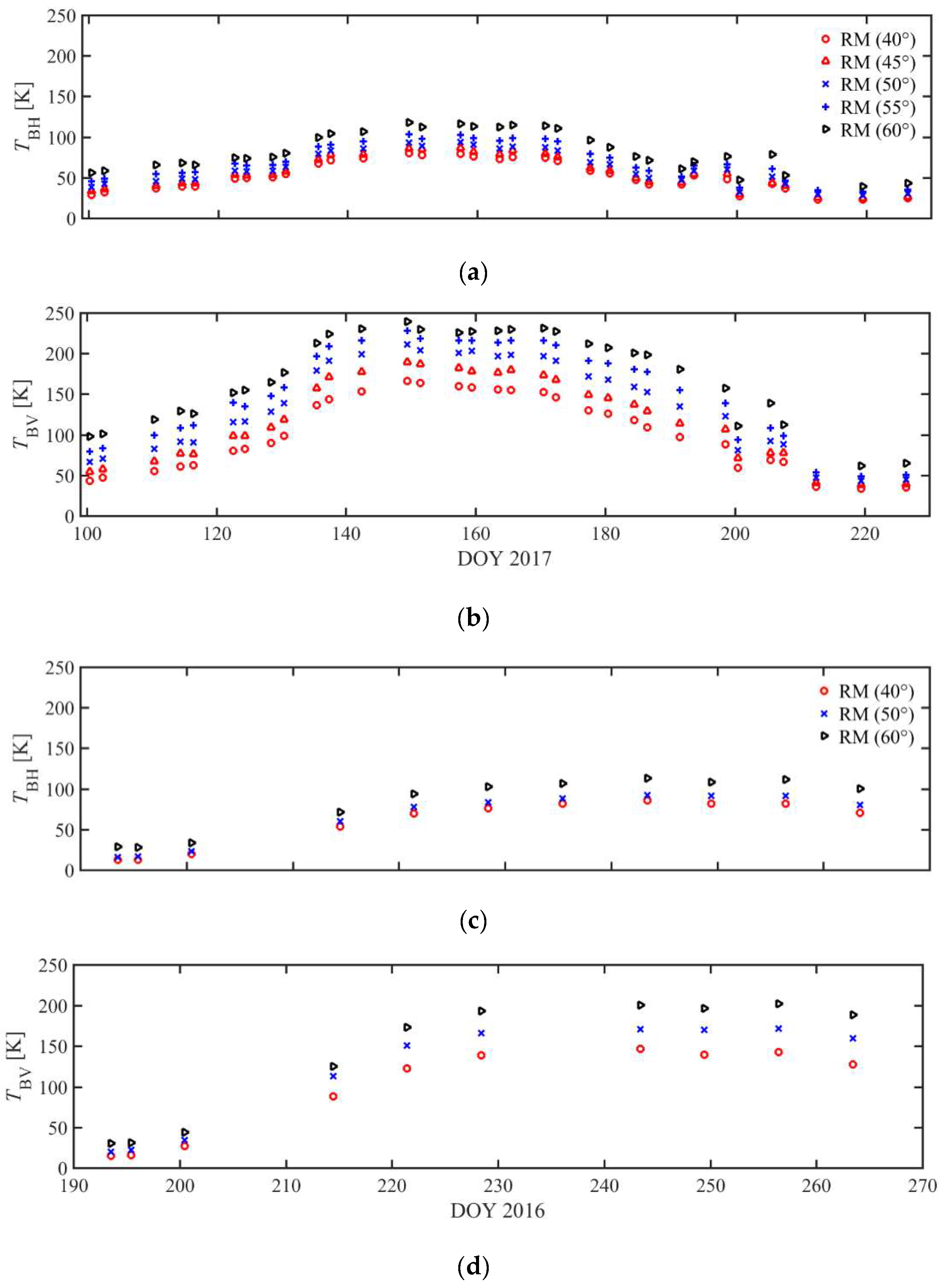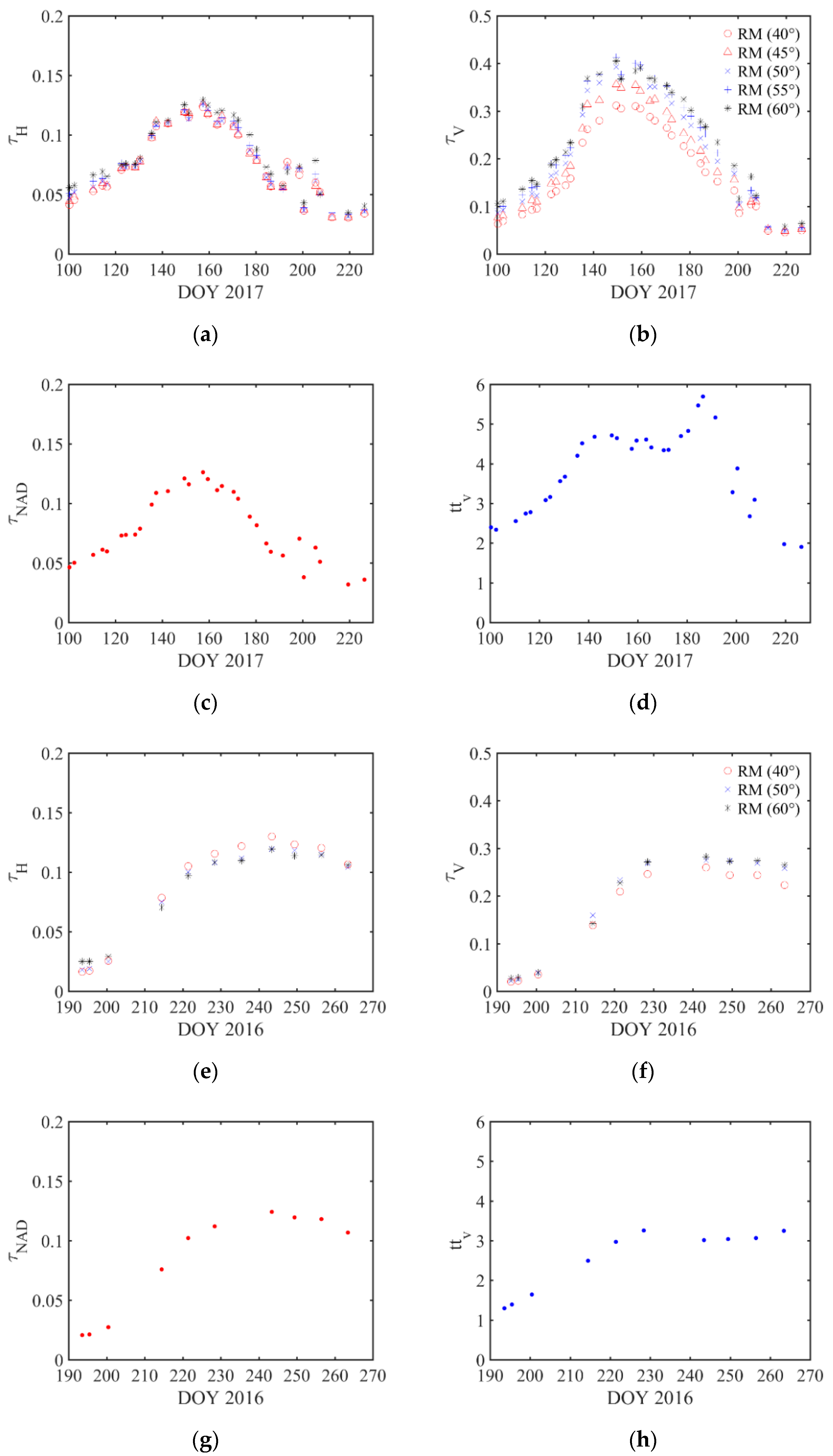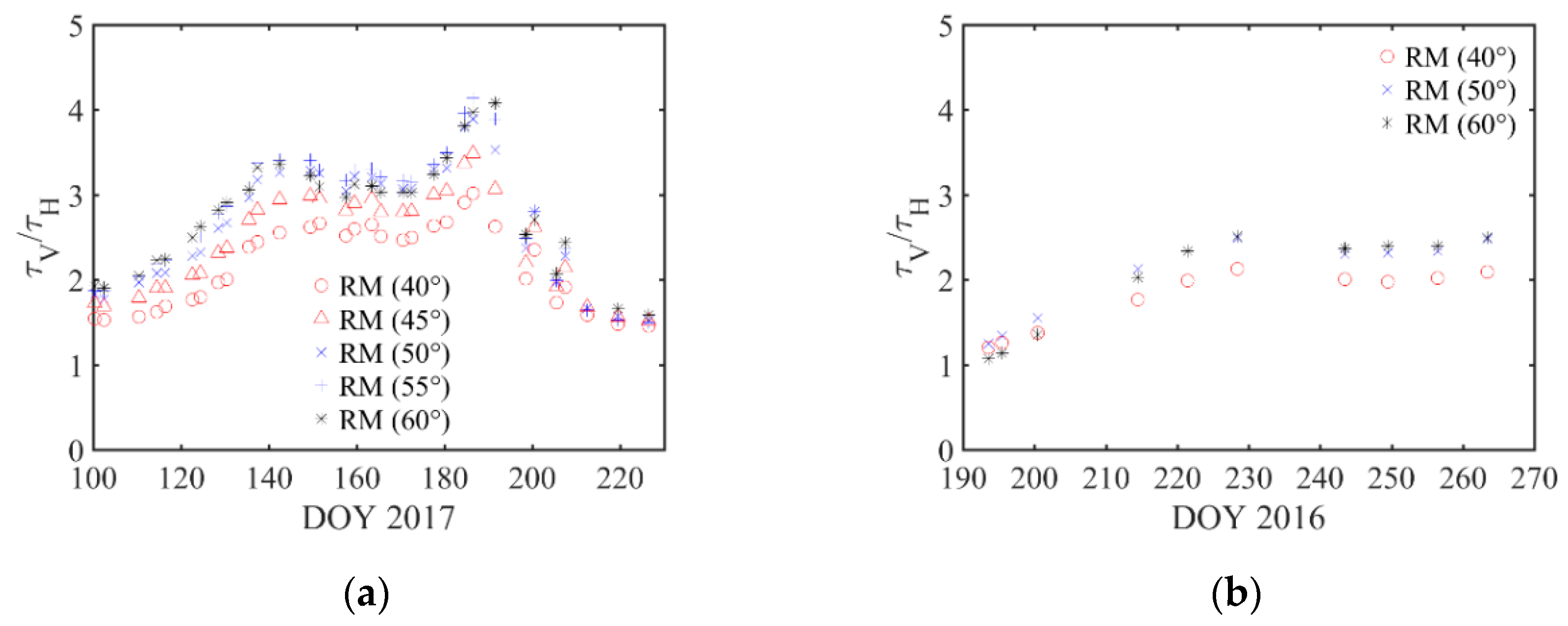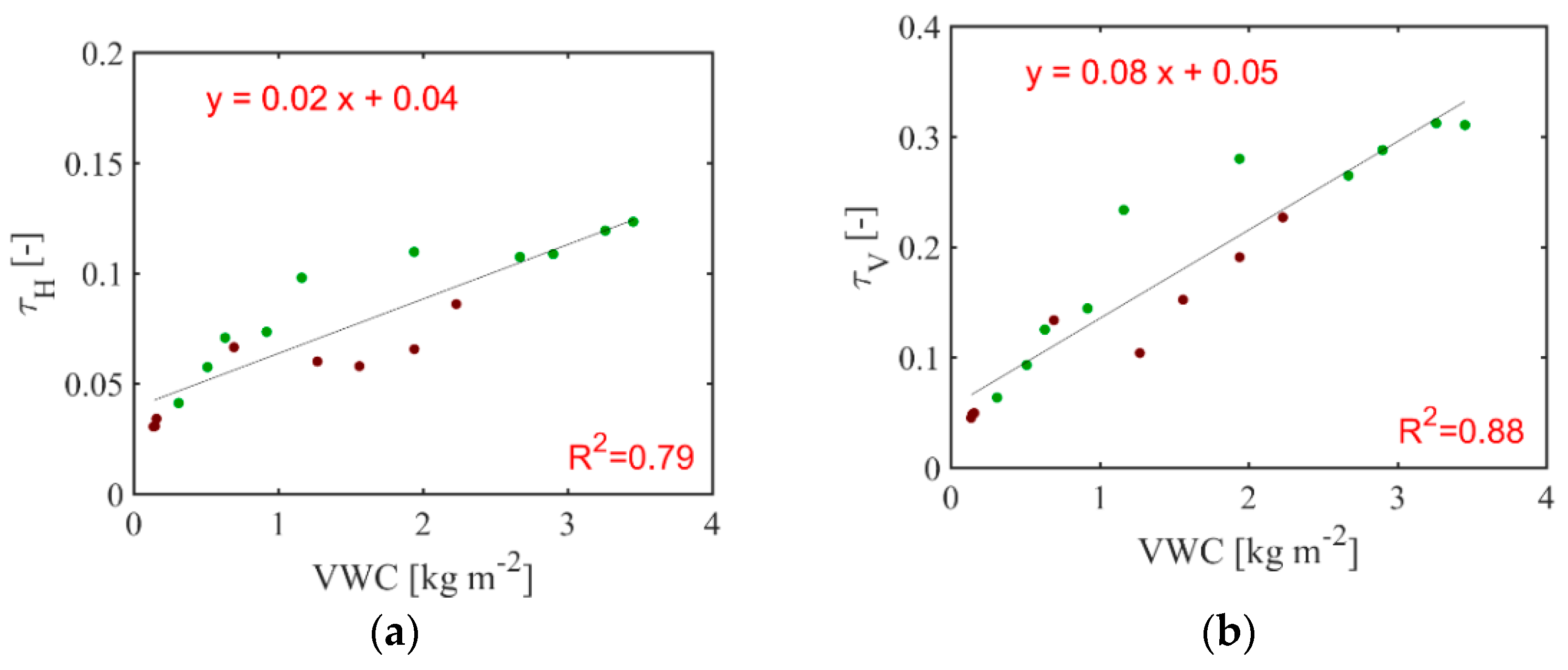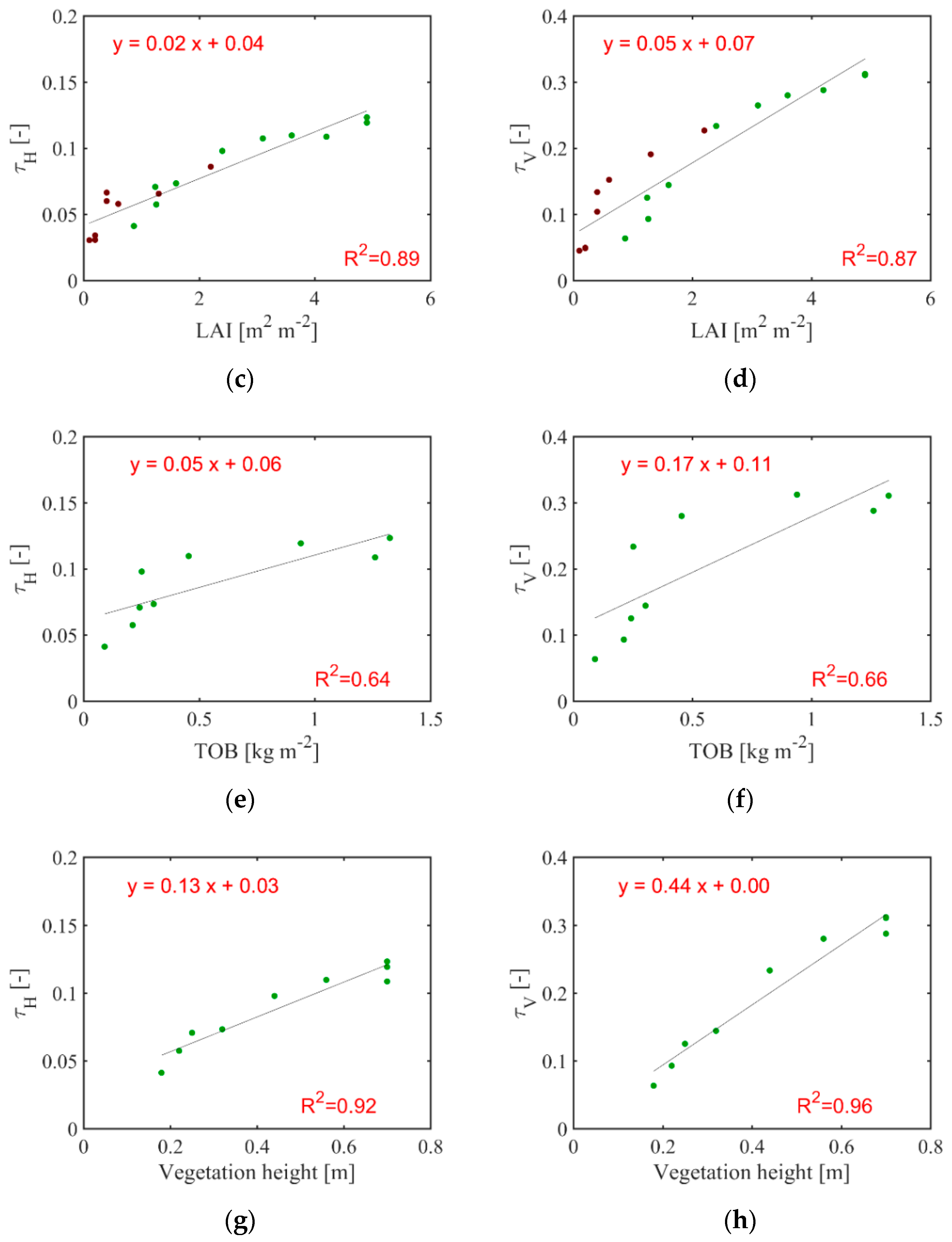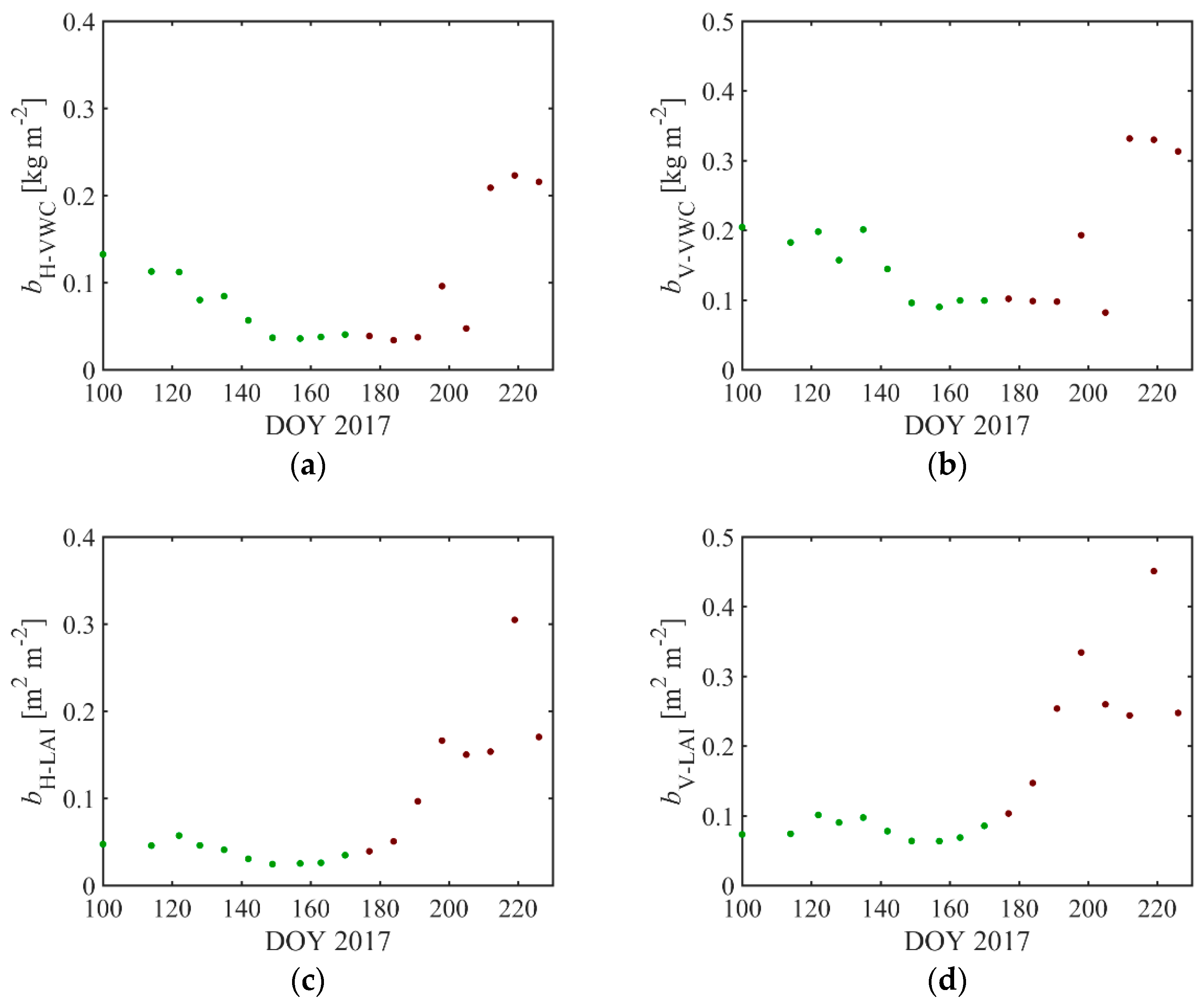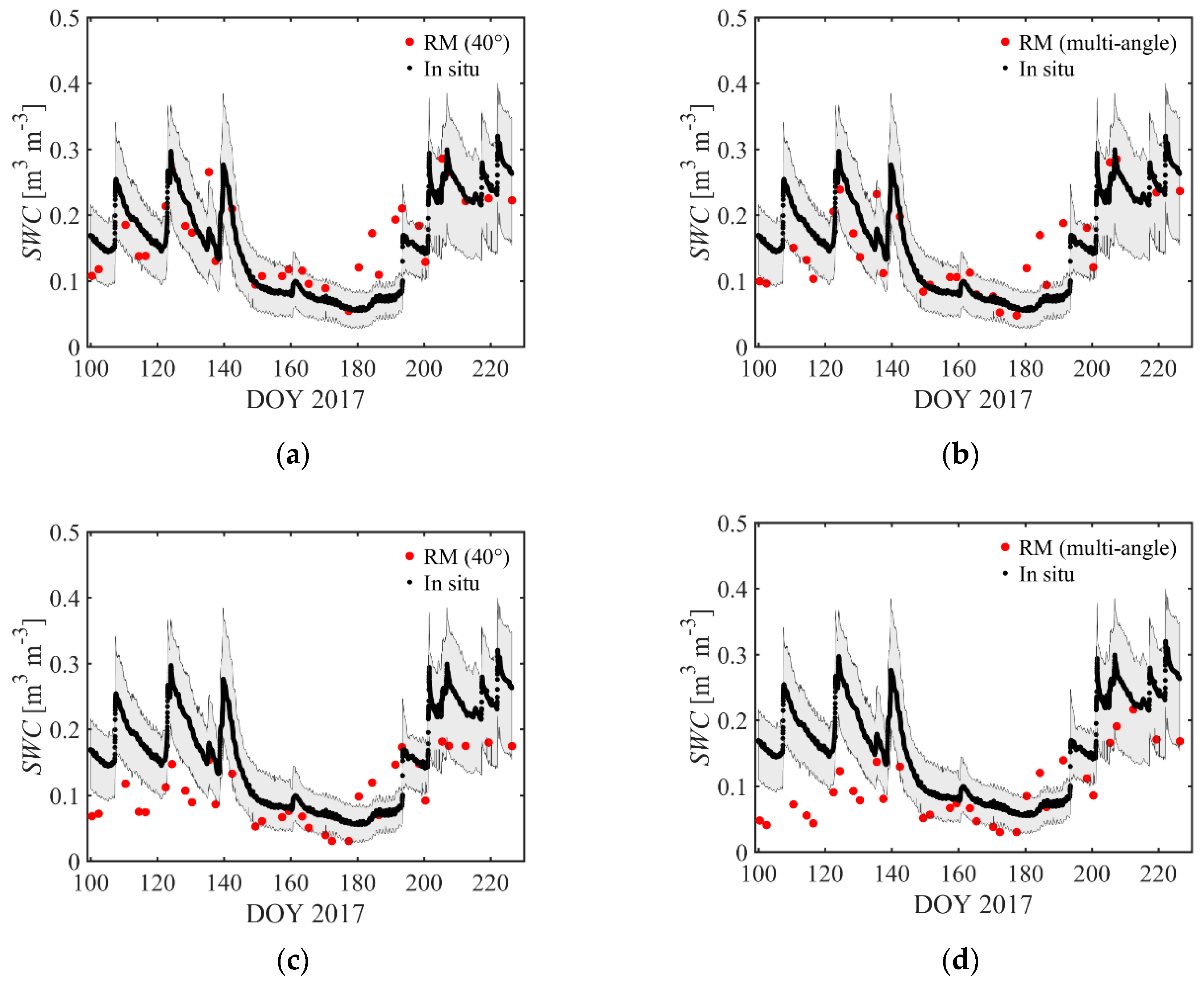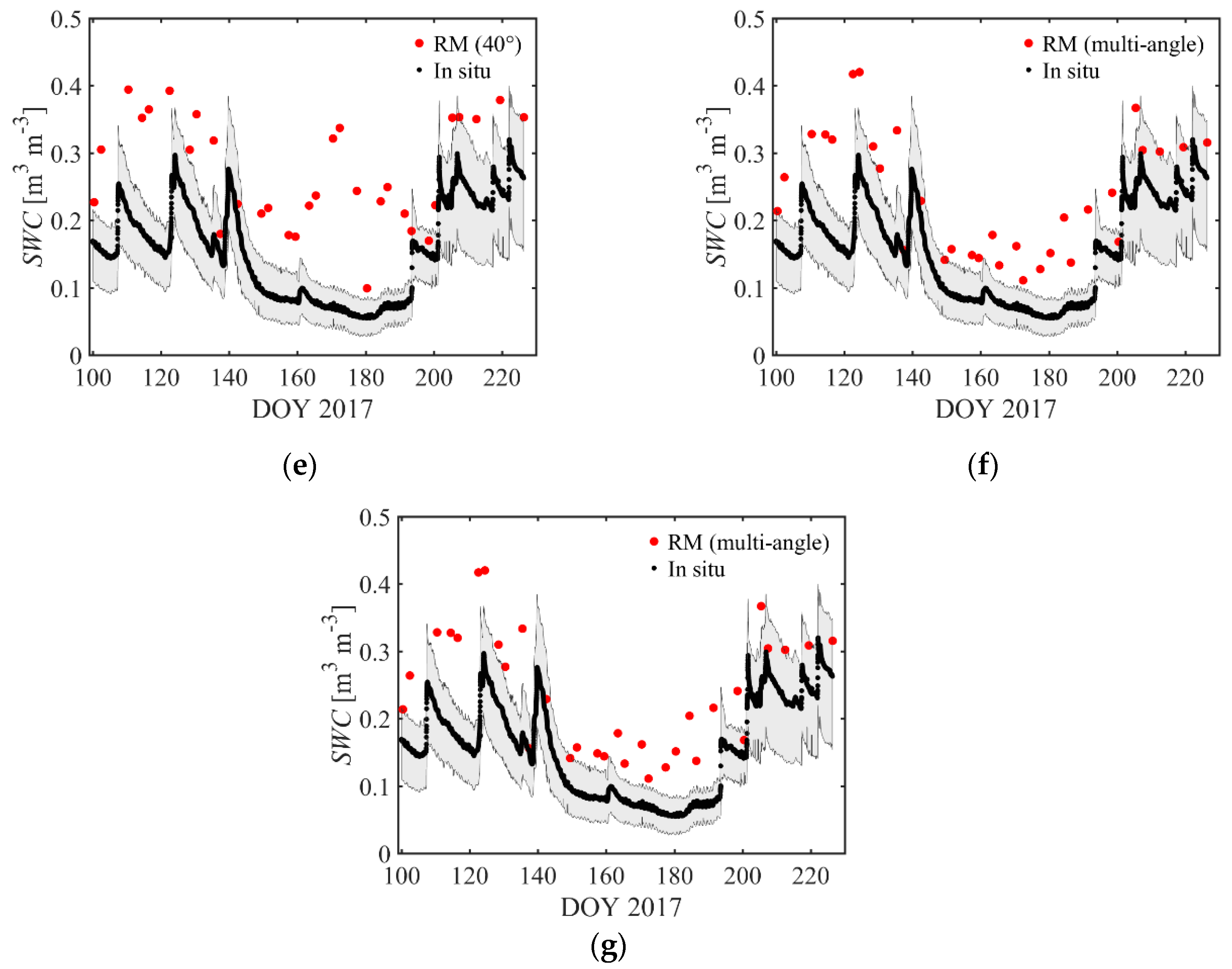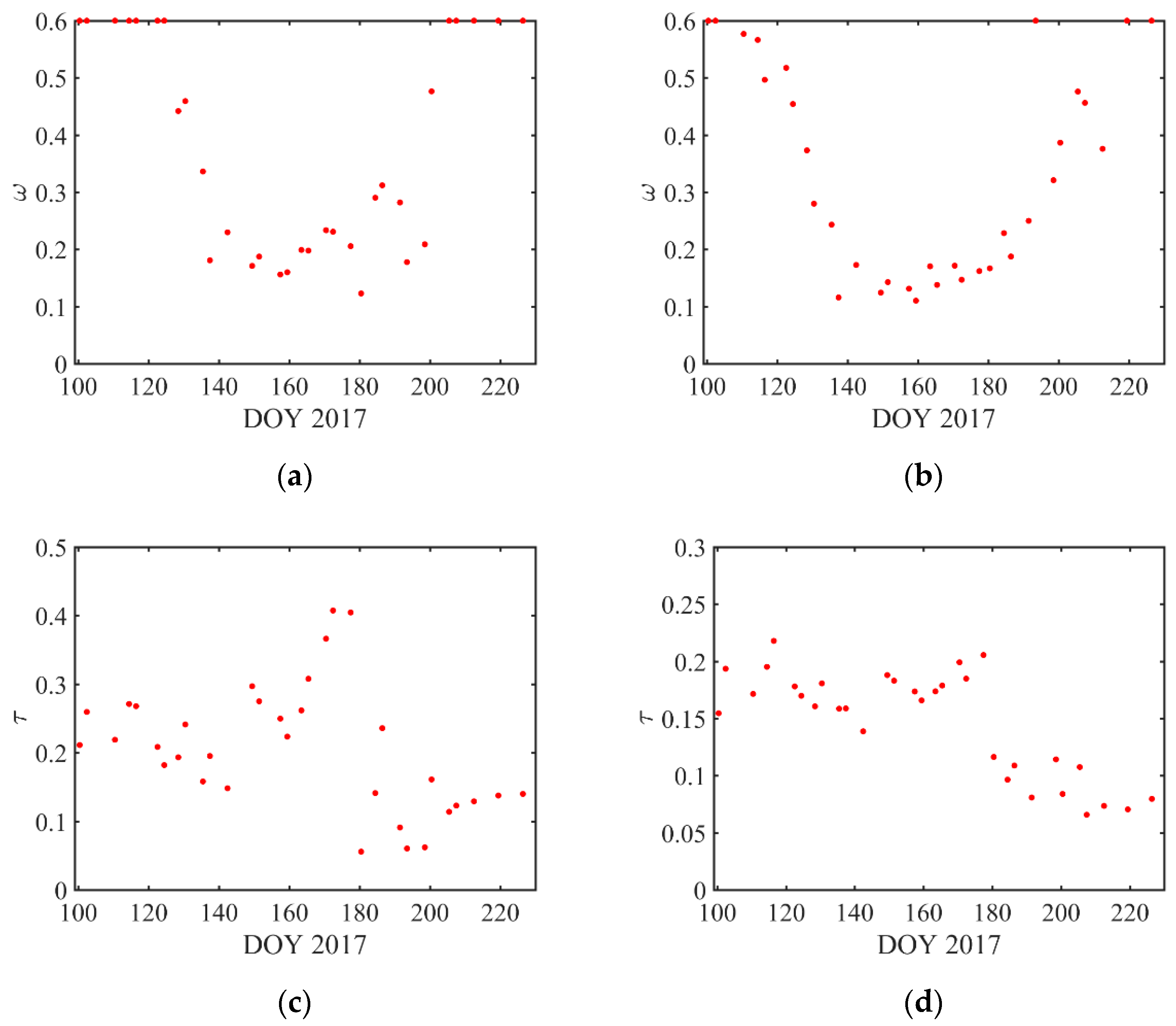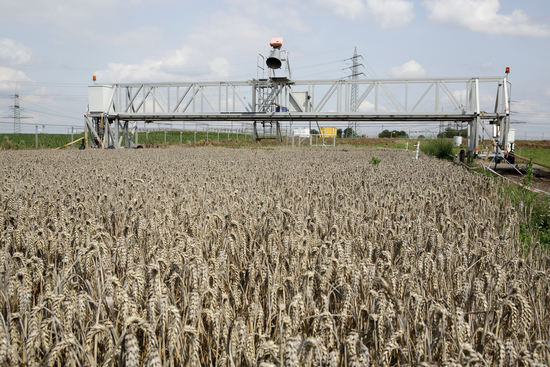4.1. Ground Truth Measurements
Figure 3a,b shows the volumetric soil water content (
SWC) measured at 5 and 30 cm depth, respectively. The black dashed line in
Figure 3a represents the temporal evolution of the mean value of all 5TM/TE (5 cm) measurements from the two sampling locations, while the black dashed line in
Figure 3b represents the temporal evolution of the mean value of all TDR (30 cm) measurements from the trench in the non-gridded plot. Additionally, the 75% quintile (grey shaded area) is depicted. As expected, higher values of
SWC can be observed at 30 cm depth in comparison to 5 cm depth with a mean value of 0.27 m
3 m
−3 at 30 cm depth and 0.16 m
3 m
−3 at 5 cm depth over the entire growing season. In general, the time course of the volumetric soil water content at 5 cm depth can be separated into three major phases. In the first phase, the time period up to DOY 140 is characterized by wetter soil conditions caused by repeated rainfall and low evapotranspiration due to colder weather conditions and low plant stand. In the second phase, the
SWC drops down between DOY 140 and DOY 193 due to low rainfall and high evapotranspiration caused by higher air temperatures and a developing crop stand. In the last phase, beyond DOY 193,
SWC increases again due to higher rainfall.
The vegetation, air, and soil temperature are depicted in
Figure 3c. The vegetation canopy temperature (
TC) and air temperature (
TA) show strong fluctuations, with a mean value of 16.2 °C and 16.1 °C and a STD of 7.1 and 6.3 °C, respectively. In comparison, the soil temperature (
TS) remains more stable over time with a slightly higher mean of 17.3 °C and a STD of 4.6 °C. In this sense, there is no significant difference between the
TC and
TA, and also, the difference between the
TC and
TS is negligible (about 1 °C).
Finally, the daily precipitation (P) is shown in
Figure 3d, which is an important influencing factor on the measured
TB and also a factor controlling the plant growth. As can be seen, only a few rain events occur during the period between DOY 100 and 180, while more frequent rainfalls can be observed after DOY 180. The cumulative precipitation over the experimental time course was 210 mm.
Figure 4a–d depicts all vegetation properties which were measured weekly in situ or in the laboratory over the entire growing season. Additionally,
Table 2 gives an overview of the growth stages of the winter wheat and their corresponding BBCH scale values. The vegetation height, the leaf area index (LAI), and the vegetation water content (VWC) increased during the first 50 days of the growing season, reaching a maximum value of about 0.7 m, 5 m
2 m
−2, and 3.5 kg m
−3, respectively, and started to decline after DOY 160. The total of aboveground biomass (TOB) reached a maximum value of about 1.5 kg m
−2 around 40 days later on DOY 190. These different developments correspond to specific growing stages. The field campaign started during the tillering stage (BBCH 26) at DOY 100, followed by a stable stem elongation period (BBCH 30) with no significant change between DOY 108 and 122. After the air temperature started to increase and stayed above 10 °C, the growing stage increased to a BBCH scale value of 35 between DOY 128 and 142, which corresponds to a further stem elongation. Between DOY 142 and 149, the plant growth rate of the winter wheat canopy increased exponentially, and about 50% of the inflorescence was visible at the end of this period (BBCH 55). The whole timeframe between DOY 120 and 150 is characterized by a strong increase in the measured vegetation properties. With the beginning of the flowering (BBCH 61) at DOY 157, a clear decline of the LAI and VWC was detectable, and the vegetation height also began to decrease. The grain development (BBCH 71) started a few days later, around DOY 163, and a further decline of the measured vegetation properties was observable (strongest for the VWC and LAI, not yet for TOB). The grain was fully developed (BBCH 77) at around DOY 180 and had already started with the ripening process (BBCH 83 until 89) in some parts of the stand. Around DOY 190, the early senescence phase started (BBCH 92), after which the TOB also began to decrease due to vegetation loss (mainly leaves and grains). DOY 226 represents the totally senescent vegetation (BBCH 99), where the LAI and VWC dropped to their minimum values, but the vegetation height and TOB remained relatively constant, as the vegetation was not harvested before the end of this experiment.
Finally, whether the weather and soil moisture conditions were sufficient to support plant growth over the entire growing season was investigated. As can be seen from
Figure 3 and
Figure 4, the temporal evolution of the measured vegetation properties and
SWC do not indicate any clear water stress nor stagnation in growth and biomass gain during the whole growing season.
4.2. Radiometer Data
4.2.1. Radiometer Measurements over the Gridded Plot
Figure 5a,b depicts the L-band brightness temperatures (
TB) at H and V polarization observed over the gridded plot within the winter wheat stand. For both polarizations, a clear seasonal trend is detectable, which can be generally separated into three phases. In the first phase,
TB increased at the beginning of the growing season, reaching a first peak at DOY 140. This increase in
TB corresponds well to the increase of the above-mentioned vegetation properties (see also
Section 4.4). In the second phase, between DOY 145 and DOY 175,
TB values were relatively stable over time. Within this period, also, no significant changes in the vegetation layer were detectable. During the third phase, starting after DOY 175 and continuing until the end of the growing season (DOY 226),
TB significantly decreased. This decrease in
TB is mainly related to the reduction in VWC and LAI (due to leaf loss), whereby the vegetation height and TOB remained constant during the same period.
Secondly, TBV measurements show a higher temporal variability with general higher values over the entire growing period, but also a larger increase during the crop development compared to TBH. This observation can be explained by the stronger vertical orientation of the wheat canopy, leading to a higher emission contribution in the V polarization.
Furthermore, a clear angle dependency with highest TB values at 60° angle is detectable, whereby the angular dependency is much more pronounced for TBV compared to TBH. The lower variability over time of TBH can be also confirmed by the lower STD values. For TBH, the mean values are 52.6 K (40°), 56.7 K (45°), 62.2 K (50°), 70 K (55°), and 82.6 K (60°), with a STD ranging between 18.4 K (40°) and 23.6 K (60°), while for TBV, the mean values are 108.4 K (40°), 124.1 K (45°), 138.1 K (50°), 153.8 K (55°), and 172.6 K (60°), with a STD of 53 K (same for all angles). Additionally, the magnitude of the angular dependency does not change much between DOY 100 and DOY 200 for either polarization. After DOY 200, the angular dependency disappears at a stage when the vegetation begins senescence, which confirms that this dependency is mainly caused by changes in VWC and LAI. In summary, these results show that the changes in TB are mainly driven by the vegetation status. This proves that our setup is adequate to detect significant contrasts in TB, and therefore, different vegetation canopy states within the radiometer footprints.
To confirm these general findings, we included data from a short experiment performed with white mustard (
Sinapis alba L.) during summer 2016 using the same setup as for the winter wheat experiment in 2017. Unfortunately, measurements for white mustard were stopped before the plant reached the senescent stage, and therefore, VWC and LAI reached only a maximum value and did not decline. The
TB measured at H and V polarization is shown in
Figure 5c,d. As can be seen, the white mustard vegetation shows the same characteristics in the
TB evolution over time as the winter wheat canopy. Compared to winter wheat, the increase and angular dependency is less pronounced in V polarization, which can be explained by the less vertically dominant structure of mustard plants and lower VWC. Additionally, the difference between
TBH and
TBV is lower in magnitude, which is confirmed by the mean values and the STD. For
TBH, mean values are 58.6 K (40°), 65.4 K (50°), and 81.3 K (60°), while the STD values are 29.4 K (40°), 31.6 K (50°), and 35.1 K (60°). On the other hand, for
TBV, the mean values are 96.2 K (40°), 117.7 K (50°), and 138.6 K (60°), while the STD values are 55.7 K (40°), 66.2 K (50°), and 74.9 K (60°).
Finally, the brightness temperature at the beginning of the mustard experiment, i.e., with the reflecting grid on the bare soil, was slightly higher than the sky brightness temperature (
TB-SKY ~ 5 K), with a mean value of 12.4 K (DOY 193) and 12.7 K (DOY 195) at H polarization and 14.8 K (DOY 193) and 16 K (DOY 195) at V polarization at a 40° incidence angle. This difference between the measured
TB above the reflecting grid and the
TB-SKY results mainly from the areas not covered by the grid, as described in Jonard et al. [
28]. However, it can be assumed that the radiance originating from the surrounding area remains stable during the experiment, allowing us to not correct for this difference. Nevertheless, using higher incidence angles leads to an increase in the contribution of the surrounding area radiance to the measured
TB.
4.2.2. Radiometer Measurements over the Non-Gridded Plot
Figure 6a,b shows the
TB measurements at H and V polarization above the non-gridded plot within the winter wheat stand. Again, both polarizations indicate comparable time courses over the growing season with relatively stable
TB between DOY 100 and DOY 140 with values of about 200 K (
TBH) and 250 K (
TBV), respectively, followed by an increase in
TB up to 250 K for
TBH and 270 K for
TBV between DOY 140 and 180. Furthermore, this general pattern is also in good agreement with the changes in the vegetation properties (mainly the VWC and LAI) (see
Figure 4a,b), whereby the more noisy character of the data is an indication of changes in the soil moisture due to precipitation events (see
Figure 3a,d). As expected,
TBV was systematically higher compared to
TBH during the entire growing period with mean values of 215.0 K (40°), 214.7 K (45°), 209.7 K (50°), 203.7 K (55°), and 195.4 K (60°) for
TBH and 247.5 K (40°), 255.9 K (45°), 259.3 K (50°), and 261.7 K (55°), and 261.5 K (60°) for
TBV. Concerning the temporal evolution,
TBH can be characterized by a stronger temporal variability compared to
TBV, with a STD of about 21 K for
TBH and about 14 K for
TBV for all incidence angles. Additionally, after DOY 180 until the end of the growing season, the
TBV only decreased by 30 K, to values around 240 K, while
TBH decreased much more significantly, by about 70 K, down to values around 150 K for the 60° angle, and by about 50 K, down to values around 190 K for the 40° angle. This strong decrease of
TBH is governed by two opposing factors, namely, the linear decrease of VWC and LAI (i.e., decrease of vegetation layer emission), and the increase of
SWC from mean values around 0.1 m
3 m
−3 to
SWC of about 0.3 m
3 m
−3 at 5 cm depth. This change in soil moisture is associated with a decrease of soil surface layer emission. Therefore, the impact of the surface soil moisture on
TB was dominant compared to the impact of the changes in VWC or LAI during the senescent phase of the winter wheat canopy.
Focusing on the angular dependency of the measured
TB,
TBH has in general a stronger angular dependency compared to
TBV. Additionally,
TBH shows a decrease with increasing incidence angle (
TB-40° >
TB-60°), which is in contrast to the observations over the gridded plot, where
TBH increases with increasing angle. It can also be seen that the sensitivity of
TBH with respect to the measurement angle increases after DOY 180 and is strongest when the vegetation layer reaches the senescence stage. This increase of the angular dependency may be explained by the larger influence of the soil layer emission (with relatively smooth surface) on the measured
TB at H polarization [
39]. In comparison, the angular dependency of
TBV (increasing
TBV with increasing incidence angle) is much weaker over the growing season, showing the strongest dependency after DOY 200.
Again, the data collected for the winter wheat were compared to the mustard experiment data. As can be seen,
TB data collected for the mustard stand shows similar patterns with a stronger temporal variation and angular dependency for
TBH (
Figure 6c,d). However, both
TBH and
TBV are, in general, higher and also more stable over the growing season of the mustard vegetation. The main reason for this can be found in the generally lower
SWC at 5 cm depth (mean value of 0.1 m
3 m
−3) with lower temporal fluctuations (STD of 0.04 m
3 m
−3) during the mustard experiment and the lower influence of the vegetation layer changes. Here, it has to be noted that the precipitation events were also less frequent with a total precipitation of only 73 mm over the entire mustard growing season. The angular dependency of
TBH becomes smaller at the end of the mustard experiment, corresponding to the highest VWC and LAI values (~3 kg m
−3 and 2 m
2 m
−2, respectively), and therefore, to a lower sensitivity of
TB to the soil layer emission.
To underline these observations, we again calculated the mean values, which are 241.5 K (40°), 232.3 K (50°), and 213.1 K (60°), and the STD values, which are 15.7 K (40°), 13.3 K (50°), and 15.7 K (60°) for TBH; while for TBV, the mean values are 264.5 K (40°), 271.1 (50°), and 269.7 K (60°) and the STD values are 10.4 K (40°), 7.6 K (50°), and 7.6 K (60°).
4.3. Vegetation Optical Depth
In this section, the results of the retrieval of the vegetation optical depth (τ
p) from the
TB data collected over the gridded plot using the τ-ω model are presented.
Figure 7 illustrates the temporal evolution of the retrieved τ
p values using the single-angle (a,b and e,f) and the multi-angle retrieval approach (c,d and g,h) at H and V polarization for the winter wheat and the white mustard vegetation, respectively.
For the wheat vegetation, the results of the τ retrieval using the single-angle approach show a pronounced temporal evolution over the growing season, with generally lower values at H (
Figure 7a) compared to V polarization (
Figure 7b). The lowest τ
p values can be observed at the beginning of the growing season (tillering stages) and at the end of the experiment during the senescence stages, while the highest values can be observed around DOY 150 to 160, corresponding to the period at the end of flowering. The mean and STD of τ
H is 0.09 and 0.03, respectively, for all different angles. The mean values of τ
V on the other hand increase with increasing incidence angle with values of 0.2 (40°), 0.23 (45°), 0.26 (50°), 0.28 (55°), and 0.31 (60°). The STD is also much higher compared to that for τ
H, with values of 0.11 (40°), 0.14 (45°), 0.15 (50°), 0.15 (55°) and 0.15 (60°). These data show a clear angular dependency of τ at V polarization. The magnitude of the angular dependency increases between DOY 140 and 160, meaning that the highest angular dependency occurred for a fully developed vegetation cover (around DOY 160), which was characterized by a maximum VWC and LAI and a maximum stem elongation. The lowest angular dependency is observed for a fully senescent vegetation canopy (after DOY 200).
For the multi-angle retrieval approach, τ was not estimated for a specific incidence angle as the
TB data from all angles were used simultaneously in the retrieval. Therefore, τ at nadir angle (τ
NAD), as well as the structural parameter
ttp used to account for polarization dependency on τ, were obtained using Equation (4). In this study,
ttH (structural parameter at H polarization) was assumed to be equal to 1, as the winter wheat has a dominant vertical structure. This was also confirmed by the results of the single-angle retrieval approach (see above), showing no significant differences between the τ retrievals at different incidence angles. As expected, using the assumption of
ttH equal 1, the temporal evolution of τ
NAD is very similar to the one observed for τ
H retrieved by the single-angle approach. Concerning the temporal evolution of
ttV, the values are the highest during the main growing phase of the vegetation (between DOY 130 and 180), showing a clear peak around DOY 193 due to wetting of the vegetation during a large rain event and lowest at the beginning and the end of the growing season (
Figure 7c,d). The mean and STD of
ttV are 3.82 and 1.05, respectively.
Concerning the retrievals of τ
H and τ
V of the mustard vegetation using the single-angle approach, there is also a clear polarization and temporal dependency observable with higher τ values in the V polarization, but less strong in magnitude compared to the winter wheat stand. Furthermore, the angular dependency of τ
V is lower, which indicates less anisotropic conditions of the mustard vegetation at L-band (
Figure 7e,f). The mean values and STD of τ
H are 0.08 and 0.18 (same for all angles), respectively, while the mean values and STD of τ
V are 0.04 and 0.11 (also same for all angles), respectively. The lower anisotropy in the vertical polarization for the mustard compared to the winter wheat can be also seen in the retrieved
ttV parameter, where the mean and STD are 2.54 and 0.80, respectively (
Figure 7g,h). Finally, the ratio between the τ
H and τ
V was also calculated and is depicted in
Figure 8a,b for wheat and mustard vegetation, respectively. It can be seen that for the wheat, the ratio varies between 2 and 4, with a very stable period during the main growing season between DOY 130 and 190 and a peak around DOY 193, which corresponds again to the wetting of the vegetation after a strong precipitation event (about 15 mm). During the tillering and the senescence stages, the difference between the H and V polarization is reduced (values around 2), which suggests more isotropic conditions. The ratio between the τ
H and τ
V for the mustard vegetation varied between 1 at the beginning of the growing season (DOY 193 to 200) and 2.5 at the end of the experiment campaign. These results confirm again that the mustard canopy is more isotropic compared to the wheat vegetation (i.e., the τ parameter is less dependent on the measurement angle and polarization). It has also to be noted that the mustard experimental campaign started with bare soil conditions, while the winter wheat plants already had a height of 20 cm at the beginning of the measurement campaign (see
Section 4.1). This can explain the higher τ values for winter wheat during the first measurement days.
4.4. Relationship between Vegetation Optical Depth and In Situ Measured Vegetation Properties
In this section, the relationships between the retrieved vegetation optical depth and in situ measured vegetation properties (VWC, LAI, TOB, and vegetation height) are analyzed based on linear regressions. For that, the τ values retrieved from the 40°
TB data measured over the gridded plot (see
Figure 7a,b) were used. The results of these regressions are shown in
Figure 9a–h. As the in situ vegetation parameters were only measured at 19 observation dates (see
Figure 4a–d), the corresponding τ
p values were only selected for those days, reducing the number of observation pairs to
n = 18. Additionally, for the TOB and vegetation height, as we are only interested in the plant growth stages (i.e., when plants grow and vegetation water content rises) for the relationship between τ
p and these two parameters, only the first ten measurements were selected for the regression reducing the number of observation pairs to
n = 9. Indeed, these two vegetation parameters do not show the same bell-shaped temporal evolution as τ, but mainly an increase for the early growing stages until DOY 150, and then constant values followed by a small reduction in the late growing stages (see
Figure 4c,d).
Figure 9 shows the linear regressions between τ
p and the vegetation properties. The slope, intercept, and R
2 are also depicted on the plots. In general, high correlations between τ and the vegetation parameters are obtained with R
2 values ranging from 0.64 to 0.96. The lowest correlation is obtained between τ
p and TOB with R
2 values of 0.64 and 0.66 for τ
H and τ
V, respectively, while the best correlation is observed between τ
p and the vegetation height with R
2 values of 0.94 and 0.96 for τ
H and τ
V, respectively. The correlation between τ
V and VWC and the one between τ
V and LAI show quite similar R
2 values, i.e., 0.88 and 0.87, respectively. On the contrary, the correlation between τ
H and VWC is lower, with a R
2 of 0.79, compared to that between τ
H and LAI, with a R
2 of 0.89. The lower correlation between τ
p and TOB can partly be explained by the fact that the maximum value of TOB (DOY 190) is reached later than the maximum value of τ
p (DOY 150) (see
Figure 4 and
Figure 7a,b), while the maximum values of the three other vegetation properties are reached at nearly the same time as τ
p.
The slope and the intercept of the regression lines are always positive. The slope is systematically much lower than 1, and the intercept is generally close to 0 with highest values for the TOB–τ
p relationship and lowest values for the vegetation height–τ
p relationship. The slope values for the VWC–τ
p and LAI–τ
p relationships correspond well to the ones reported by Wigneron et al. [
13] for a wheat vegetation stand, where slope values of 0.08 and 0.03 were found for the VWC–τ
p and LAI–τ
p relationships, respectively. However, Wigneron et al. [
13] found negative values for the intercepts, i.e., −0.02 and −0.01 for the VWC–τ
p and LAI–τ
p relationships, respectively. It has to be noted that in the study of Wigneron et al. [
13], vegetation optical depth at nadir angle (τ
NAD) was considered instead of τ
p.
In a next step, the so-called
b parameter was analyzed, which is classically used to relate the VWC or LAI to the τ
p parameter using:
Equation (6) has been found to be valid in several studies (e.g., [
40]). The
bVWC parameter is often set to 0.12 for agricultural crops, as reported by Wigneron et al. [
13]. In the current Level 3 SMAP algorithm (SMAP SCA), Equation (6) is used to estimate the τ parameter based on information from ancillary data of VWC extracted from MODIS NDVI data and b parameter values derived from a look up table for different land-cover classes [
41]. However, the LAI can also be used as a proxy for the estimation of τ (Equation (7)), as LAI is classically retrieved on a global scale [
13].
Figure 10 depicts the
b parameters estimated from the 40° angle τ values derived from single-angle approach. The
bVWC parameter at H and V polarization shows a clear dependency on the growing stages with decreasing values between DOY 100 and 150, relatively stable values between DOY 150 and 200, and increasing values after DOY 200 (
Figure 10a,b). The first period corresponds to strong changes in the vegetation structure (stem elongation) and the VWC, followed by a linear decrease of the VWC in the second period, with no significant changes of the vegetation structure. During the third period, a further decline of the VWC was measured as the plants became senescent. Additionally, the vegetation structure changed, whereby the wheat heads and stems were stronger orientated towards the soil surface leading to a decrease of the vegetation height and also a decrease in TOB due to a loss of leaves. The
bH-VWC parameter is, in general lower compared to
bV-VWC with a mean value of 0.09 in comparison to 0.17 for
bV-VWC.
Figure 10c,d shows that the
bLAI parameter is less sensitive to vegetation growing stages, with relatively constant values of around 0.05 for
bH-LAI and 0.1 for
bV-LAI between DOY 100 and 190. After this,
bLAI increases strongly for both polarizations as the vegetation structure changes significantly during senescence. Again, the
bLAI parameter is, in general, lower at H polarization, with a mean value of 0.08, compared to 0.16 for the V polarization.
In conclusion, the results show that the
b parameters are only constant during the middle of the growing season, i.e., when the wheat vegetation was fully developed for the VWC approach (Equation (6)), whereby for the LAI-based approach (Equation (7)), the
b parameters can be assumed to be constant for the entire growing season, except for the senescence stages. Finally, the
b parameter is, in general, higher at V polarization, which could be explained by the fact that the vegetation was predominantly oriented in the vertical direction [
23]. These results are consistent with the findings of Zakharova et al. [
42], who observed a similar evolution of a polarization-independent
bVWC parameter for low vegetation canopies (i.e., grassland, wheat and irrigated maize). They showed a clear decrease of the
bVWC parameter during the vegetation growing phase, with
b values of 0.15 during spring and values around 0.05 during summer, when the vegetation was fully grown.
4.5. Volumetric Soil Water Content
Volumetric soil water content (
SWC) was retrieved from
TB observations performed over the non-gridded area using the different retrieval schemes (1-P, 2.1-P, 2.2-P, and 3-P) described in
Section 3.2 (see
Table 1). A summary of the comparison between the measured and modeled
SWC for the different retrieval schemes is depicted in
Table 3. The unbiased root-mean-square-error (ubRMSE) [
43], bias, and coefficient of determination (R
2) values are shown for the single- and multi-angle approach, respectively. The results based on the 1-P retrieval scheme (estimation of
SWC alone) are shown in
Figure 11a,b for the single- (40° incidence angle) and multi-angle (from 40° to 60° incidence angle) approach, respectively. The estimated
SWC values are in good agreement with the in situ measurements as confirmed by the ubRMSE and bias values of 0.047 m
3 m
−3 and 0.013 m
3 m
−3 for the single-angle approach, and 0.047 m
3 m
−3 and −0.002 m
3 m
−3 for the multi-angle approach. In addition, the R
2 of 0.57 (single-angle) and 0.58 (multi-angle) also indicate a good agreement between the data sets.
The
SWC values retrieved based on the 2.1-P retrieval scheme (estimation of
SWC and ω) are illustrated in
Figure 11c,d and indicate, in general, a relatively poor agreement between the measured and modeled
SWC with a R
2 of 0.42 and 0.40 for the single- and multi-angle approach, respectively. The bias is significantly larger compared to the 1-P retrieval scheme with a value of −0.044 m
3 m
−3 for the single-angle approach and −0.056 m
3 m
−3 for the multi-angle approach. This indicates a large underestimation of the retrieved
SWC in comparison to the in situ data. Also, the ubRMSE with values of 0.054 m
3 m
−3 and 0.055 m
3 m
−3 for the single- and multi-angle approach, respectively, shows slightly higher values in comparison to the 1-P retrieval scheme. As can be seen in
Figure 12a,b, the retrieved ω values are very high at the beginning and at the end of the growing season, decrease with growing vegetation (DOY 120 till 140), then show relatively constant values around 0.1–0.2 when the vegetation is fully grown (DOY 140 till 180), and finally increase when the vegetation becomes senescent (DOY 180 till 210). These results clearly indicate that the simultaneous retrieval of
SWC and ω fails to obtain ω correctly. Indeed, values of ω at the beginning and at the end of the growing season were expected to be close to zero and, instead of a large decrease when the vegetation was fully grown, a small increase in ω was expected.
For the 2.2-P retrieval scheme (estimation of
SWC and τ),
SWC was retrieved without any prior information on the τ parameter. The 2.2-P retrieval scheme shows an ubRMSE and bias of 0.062 m
3 m
−3 and 0.124 m
3 m
−3, respectively, for the single-angle approach and 0.050 m
3 m
−3 and 0.089 m
3 m
−3, respectively, for the multi-angle approach (
Figure 11e,f). Compared to the 1-P and 2.1-P retrieval schemes, the ubRMSE increases for the single-angle approach and slightly decreases for the multi-angle approach, and the bias of both approaches indicates a high overestimation of the modeled
SWC values. Additionally, the R
2 of 0.43 for the single-angle approach indicates a relatively low correlation between modeled and measured
SWC. On the contrary, the R
2 of 0.68 for the multi-angle approach indicates a good agreement. As shown in
Figure 12c,d, the bell-shaped temporal evolution of τ retrieved from the gridded plot
TB data (see
Figure 7a–d) could not be obtained for the single- and multi-angle approaches. However, for the single-angle approach, a clear increase in values around 0.4 between DOY 160 and DOY 180 is observed (
Figure 12c), while for the multi-angle approach, the τ values are, in general, lower and show even lower temporal variations, with values around 0.1–0.2 (
Figure 12d).
Finally, the results of the 3-P retrieval scheme (estimation of
SWC, τ
NAD, and
ttV) using the multi-angle approach are depicted in
Figure 11g. It has to be noted that the single-angle approach could not be used to retrieve three parameters, as not enough information is contained in the
TB measurements with only one incidence angle. The results show identical ubRMSE, bias, and R
2 values as the 2.2-P retrieval scheme based on the multi-angle approach. This can be explained by the fact that the 3-P approach did not succeed to retrieve the
ttV parameter correctly. Indeed, the retrieved
ttv values are close to 1 for the whole growing period (results not shown), while
ttV is expected to be higher than 1 for wheat vegetation ([
13] and see
Figure 7d), and the retrieved τ
NAD values do not differ significantly from the τ values obtained with the 2.2-P retrieval approach using multiple angles (results not shown). The 3-P retrieval scheme is therefore not able to obtain the structural effect of vegetation on τ (polarization dependency), which can be expected because
ttv and τ
NAD are highly correlated.
The simultaneous retrieval of a time-dependent ω and a time-dependent τ with
SWC was also tested, but no consistent results were obtained (results not shown). As described in Konings et al. [
21], this can be explained by the fact that ω and τ compensate for each other in the τ-ω model when the emission contribution from the soil is small in comparison to the canopy emission contribution, which leads to unrealistically large temporal variations in both retrieved parameters. We hypothesize that an alternative would be to use different ω values for specific growing stages.
